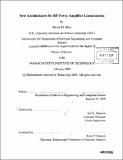New architecture for RF power amplifier linearization
Author(s)
Boo, Hyun Ho
DownloadFull printable version (24.30Mb)
Alternative title
New architectures for radio frequency power amplifier linearization
Other Contributors
Massachusetts Institute of Technology. Dept. of Electrical Engineering and Computer Science.
Advisor
Joel L. Dawson.
Terms of use
Metadata
Show full item recordAbstract
Power amplifier linearization has become an important part of the transmitter system as 3G and developing 4G communication standards require higher linearity than ever before. The thesis proposes two power amplifier linearization solutions : two-point architecture and adaptive digital predistortion using a [delta sigma] modulator for automatic inversion of power amplifier nonlinearity. Two-point architecture can be seen as a solution that extends the linearization bandwidth of the traditional feedback architecture while also offering decent digital predistortion linearization at much higher frequencies as well. It overcomes the bandwidth problem by combining Cartesian feedback and digital predistortion. As the Cartesian feedback loses its loop gain in high frequencies, the predistorted signal gradually takes over the linearization role. Effectively, this increases the operation bandwidth of the Cartesian feedback and allows wide-band transmission. For digital predistortion, the complexity involved in the implementation of adaptive algorithm and convergence issues in the look-up table training has limited its application in handset devices. Predistortion using a [delta sigma] modulator presented in this work eliminates these problems as it is based on open-loop look-up table training and does not require adaptive algorithm.
Description
Thesis (S.M.)--Massachusetts Institute of Technology, Dept. of Electrical Engineering and Computer Science, 2009. Includes bibliographical references (p. 51-55).
Date issued
2009Department
Massachusetts Institute of Technology. Department of Electrical Engineering and Computer SciencePublisher
Massachusetts Institute of Technology
Keywords
Electrical Engineering and Computer Science.